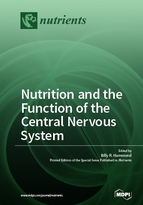Nutrition and the Function of the Central Nervous System
A special issue of Nutrients (ISSN 2072-6643).
Deadline for manuscript submissions: closed (15 February 2018) | Viewed by 99894
Special Issue Editor
Interests: nutritional neuroscience; carotenoids; macular pigment; lutein/zeaxanthin; sensory; vision
Special Issues, Collections and Topics in MDPI journals
Special Issue Information
Dear Colleagues,
This Special Issue of Nutrients is focused on the role of nutrition in the development and maintenance of the central nervous system (CNS, primarily retina and brain). This focus encompasses both nutritional effects on normal function and the prevention and treatment of CNS disease. The critical role of diet in most bodily systems (such as the cardiovascular or skeletal system) and in the prevention of disease (e.g., metabolic conditions, such as acquired diabetes) is largely accepted as an axiom. It is only relatively recently, however, that researchers, particularly neuroscientists, began to focus on how diet influences the very organ system that is at the center of our self, the brain. The retina is the most metabolically active tissue in the body and is impacted early by metabolic diseases such as diabetes. The brain is some 2% of our mass but about 20–25% of inspired oxygen is delivered to this highly vascularized fatty (some 60% by volume) tissue. The CNS is not simply influenced by diet, it is built from, maintained, and preserved by diet. This premise is explored in this Special Issue.
Dr. Billy Hammond
Guest Editor
Manuscript Submission Information
Manuscripts should be submitted online at www.mdpi.com by registering and logging in to this website. Once you are registered, click here to go to the submission form. Manuscripts can be submitted until the deadline. All submissions that pass pre-check are peer-reviewed. Accepted papers will be published continuously in the journal (as soon as accepted) and will be listed together on the special issue website. Research articles, review articles as well as short communications are invited. For planned papers, a title and short abstract (about 100 words) can be sent to the Editorial Office for announcement on this website.
Submitted manuscripts should not have been published previously, nor be under consideration for publication elsewhere (except conference proceedings papers). All manuscripts are thoroughly refereed through a single-blind peer-review process. A guide for authors and other relevant information for submission of manuscripts is available on the Instructions for Authors page. Nutrients is an international peer-reviewed open access semimonthly journal published by MDPI.
Please visit the Instructions for Authors page before submitting a manuscript. The Article Processing Charge (APC) for publication in this open access journal is 2900 CHF (Swiss Francs). Submitted papers should be well formatted and use good English. Authors may use MDPI's English editing service prior to publication or during author revisions.
Keywords
- Central Nervous System
- diet
- gut-brain axis
- carotenoids
- neuroimaging







